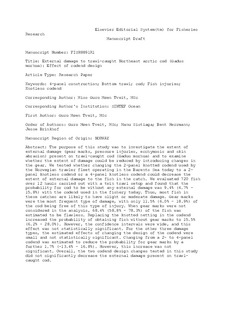| dc.contributor.author | Tveit, Guro Møen | |
| dc.contributor.author | Sistiaga, Manu Berrondo | |
| dc.contributor.author | Herrmann, Bent | |
| dc.contributor.author | Brinkhof, Jesse | |
| dc.date.accessioned | 2019-03-25T13:10:40Z | |
| dc.date.available | 2019-03-25T13:10:40Z | |
| dc.date.created | 2019-02-18T18:31:26Z | |
| dc.date.issued | 2019-06 | |
| dc.identifier.citation | Fisheries Research, Volume 214, pages 136-147 | nb_NO |
| dc.identifier.issn | 0165-7836 | |
| dc.identifier.uri | http://hdl.handle.net/11250/2591605 | |
| dc.description.abstract | The purpose of this study was to investigate the extent of external damage (gear marks, pressure injuries, ecchymosis and skin abrasion) present on trawl-caught cod (Gadus morhua) and to examine whether the extent of damage could be reduced by introducing changes in the gear. We tested whether changing the 2-panel knotted codend used by the Norwegian trawler fleet operating in the Barents Sea today to a 2-panel knotless codend or a 4-panel knotless codend could decrease the extent of external damage to the fish in the catch. We evaluated 720 fish over 12 hauls carried out with a twin trawl setup and found that the probability for cod to be without any external damage was 9.4% (4.7% - 15.8%) with the codend used in the fishery today. Thus, most fish in these catches are likely to have slight or moderate damage. Gear marks were the most frequent type of damage, with only 11.5% (6.0% - 18.9%) of the cod being free of this type of injury. When gear marks were not considered in the analysis, 68.4% (58.8% - 78.3%) of the fish was estimated to be flawless. Replacing the knotted netting in the codend increased the probability of obtaining fish without gear marks to 15.5% (6.2% - 28.0%). However, the confidence intervals were wide, and this effect was not statistically significant. For the other three damage types, the estimated effects of changing the design of the codend were small and not statistically significant. Changing from a 2- to 4-panel codend was estimated to reduce the probability for gear marks by a further 1.7% (-13.4% - 16.8%). However, this increase was not significant. Overall, the two codend design changes tested in this study did not significantly decrease the external damage present on trawlcaught cod. | nb_NO |
| dc.description.abstract | External damage to trawl-caught Northeast arctic cod (Gadus morhua): Effect of codend design | nb_NO |
| dc.language.iso | eng | nb_NO |
| dc.publisher | Elsevier | nb_NO |
| dc.rights | Attribution-NonCommercial-NoDerivatives 4.0 Internasjonal | * |
| dc.rights.uri | http://creativecommons.org/licenses/by-nc-nd/4.0/deed.no | * |
| dc.subject | 4-panel construction | nb_NO |
| dc.subject | Bottom trawl | nb_NO |
| dc.subject | Cod | nb_NO |
| dc.subject | Fish injuries | nb_NO |
| dc.subject | Knotless codend | nb_NO |
| dc.title | External damage to trawl-caught Northeast arctic cod (Gadus morhua): Effect of codend design | nb_NO |
| dc.type | Journal article | nb_NO |
| dc.type | Peer reviewed | nb_NO |
| dc.description.version | acceptedVersion | nb_NO |
| dc.source.journal | Fisheries Research | nb_NO |
| dc.identifier.doi | 10.1016/j.fishres.2019.02.009 | |
| dc.identifier.cristin | 1678507 | |
| cristin.unitcode | 7566,2,0,0 | |
| cristin.unitname | Sjømatteknologi | |
| cristin.ispublished | false | |
| cristin.fulltext | postprint | |
| cristin.qualitycode | 1 | |

